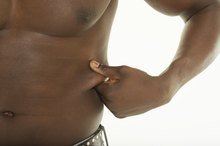The Best Way to Lose Weight From Your Midsection
Losing your belly is not just a matter of looking good in a bathing suit, it is a matter of life and death. The National Heart Lung and Blood Institute, among other health organizations, now considers the size of your midsection an indicator for your risk of developing chronic disease. The best way to prevent these risks is to prevent the accumulation of fat at your abdomen in the first place. If you already have a thick middle, experts, including Harvard Medical School and MayoClinic.com, say the best way to lose it is through diet and exercise.
Significance
Fat around your midsection is primarily visceral fat, which lies deep within your internal organs. If your waist circumference measures greater than 35 inches as a woman or 40 inches as a man, your risk of developing some cancers, type 2 diabetes, stroke, heart disease and dementia is greater than for people who have slimmer middles. You are also more likely to suffer from high cholesterol, high insulin, high triglycerides and high blood pressure. Unlike the subcutaneous fat which lies just under the skin’s surface on your thighs and hips, visceral fat may secrete hormones that cause inflammation and make disease more likely to occur. Where you gain weight depends on your genes, hormone levels, age, birth weight and lifestyle. Men, postmenopausal women, people with a history of low birth weight and women who have had children are all more likely to develop belly fat. These risk factors compound if you do not exercise and eat an unhealthy diet.
Research
The Best Way to Reduce Visceral Belly Fat
Learn More
Exercise is the best way to attack your thick middle. Belly fat responds to exercise better than the fat on your hips and thighs. A Duke University study in the October 2005 issue of the “Journal of Applied Physiology” found that overweight men and women who participated in a high amount of vigorous-intensity exercise -- equivalent to jogging 20 miles per week -- lost significant amounts of visceral and subcutaneous abdominal fat after six months. A later study published in the November 2011 issue of the “American Journal of Physiology, Endocrinology and Metabolism” also concluded that aerobic exercise is the most time-efficient and effective exercise mode to lose visceral fat.
In Practice
Harvard Medical School suggests a minimum of 30 to 40 minutes of moderate-intensity activity most days of the week. Activities that get your heart pumping and force you to breathe a little heavier are considered moderate intensity. Try riding your bike, power walking, swimming, dancing or jogging, for example. Including more regular physical activity into your day can also help you expedite a shrinking middle. Stand while taking phone calls at work, park far out in the lot and opt for the stairs over the escalator to increase your overall daily calorie burn. Once you lose your midsection, keep up with the regular physical activity and exercise to maintain the loss. A study in a 2010 issue of “Obesity” found that women who exercised just two times per week for 40 minutes staved off a return of visceral fat for an entire year while their nonexercising counterparts experienced a 38 percent increase in the toxic fat.
Diet
The Best Diet Plan for Men Over 50
Learn More
All the exercise in the world may be in vain if you fail to eat right. Reducing your intake of processed sugar, white flour, saturated and trans fats and alcohol can help you slim down your midsection. Replace these foods with fresh fruit, whole grains – such as brown rice and oats – poly- and monounsaturated fats and water or green tea. Even if you make these healthy switches, you’ll have to pay attention to portion sizes. Too much food, even healthy varieties, can keep your midsection from reducing in size.
Additional Strategies
While diet and exercise are the best ways to reduce a midsection, you can undertake additional strategies to help you reach your goals. Harvard Medical School recommends you quit smoking, because people who smoke have more visceral fat than those who do not. You should also aim to get seven to nine hours of sleep per night to ensure proper hormone regulation. Keeping stress, depression and anger at bay reduces the circulation of the hormone cortisol, which can also contribute to a wider middle.
Related Articles
References
- Journal of Applied Physiology: Inactivity, Exercise, and Visceral Fat
- American Journal of Physiology, Endocrinology and Metabolism: Effects of Aerobic vs. Resistance Training on Visceral and Liver Fat Stores, Liver Enzymes, and Insulin Resistance
- MayoClinic.com: Belly Fat in Men: Why Weight Loss Matters
- Harvard Women's Health Watch: Taking Aim at Belly Fat
- Obesity: Exercise Training Prevents Regain of Visceral Fat for 1 Year Following Weight Loss
- National Heart Lung and Blood Institute: Assessing Your Weight
- USA Today: Middle-Aged with Middle Fat? Dementia Risk Increases
Writer Bio
Andrea Cespedes is a professionally trained chef who has focused studies in nutrition. With more than 20 years of experience in the fitness industry, she coaches cycling and running and teaches Pilates and yoga. She is an American Council on Exercise-certified personal trainer, RYT-200 and has degrees from Princeton and Columbia University.









